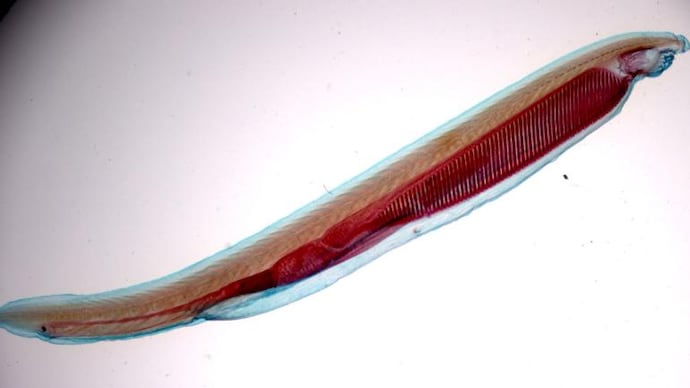Ancient marine animal 'Amphioxus' reveals surprises about our DNA
A DNA deep-dive by scientists into the marine organism 'Amphioxus' has uncovered that the tricks DNA uses to control gene expression -- which genes are turned on and off, and when -- may have originated much earlier than was previously thought.

A ground-breaking study conducted by researchers from Garvan Institute of Medical Research, Sydney, along with an international team of collaborators from Spain, France and the UK, has revealed that our genomes have much more in common with those of ancient organisms than we ever knew.
The findings are published today in the Nature journal.
The team's deep dive into the DNA of the ancient marine organism 'Amphioxus' has uncovered that the tricks DNA uses to control gene expression -- which genes are turned on and off, and when -- may have originated much earlier than was previously thought, as per Garvan Institute.
One code, many messages
- How is it that a blood cell and a brain cell have the exact same DNA -- yet they do such different things?
- "Your DNA is a powerful code," says Ozren Bogdanovic from Garvan Institute of Medical Research, one of the lead authors of the study
- "What you do with that code -- how you read it, when you read it, and what parts you read -- is just as powerful," he adds
DNA regulation, methylation
"In blood cells, some parts of the code are turned on -- so proteins that bind oxygen are present. But in brain cells, DNA makes sure those same parts are off and other parts on -- so proteins that can send electrical signals are present instead. The way each cell makes those choices is what we call 'DNA regulation,'" Bogdanovic explains.
In their study, Bogdanovic and his collaborators focused on a type of DNA regulation process called 'DNA methylation' -- a chemical modification of the DNA that tells genes when to switch on or off.
Also read | Major differences between DNA and RNA
Meet our distant relative, Amphioxus
In an effort to better understand how DNA methylation controls DNA, the team turned to one of our distant relatives -- an ancient, translucent fish-like organism called 'Amphioxus'.
This small marine organism -- full name Branchiostoma lanceolatum -- spends majority of its life buried in the sand, filter-feeding a variety of plankton.
Although they have a similar body plan to fish, their lack of paired fins or limbs makes them quite poor swimmers.
Why Amphioxus?
Most studies on DNA methylation have focused on organisms that are either too similar to humans, like mice -- also a mammal -- or too different, like flies, which have zero DNA methylation.
We have been missing the 'Goldilocks zone' -- not too close, not too distant, just right -- for understanding methylation.
Humans are 'vertebrates', which is a group that includes mammals, birds, fish, while flies are 'invertebrates' -- insects, worms, jellyfish.
With Amphioxus, we have one of the closest living invertebrate relatives to humans -- almost a vertebrate, but not quite.
A world's first in an invertebrate
- We have always believed that DNA methylation, as a method of DNA regulation, was found only in vertebrates, says Bogdanovic
- In Amphioxus, they discovered a remarkable thing -- the first-ever evidence of DNA methylation as a tool to regulate gene expression in an invertebrate
- Their findings suggest that this method of DNA regulation is much older than previously thought
"It tells us that this mechanism of regulation might have appeared a lot earlier -- millions of years earlier," says Bogdanovic.
"And this tells us a lot about how DNA regulation evolved, but also helps us understand more about how it works in more complex organisms, like ourselves," he adds.
Vertebrates v/s invertebrates
This small, curious marine organism has offered a unique research opportunity.
"Amphioxus lies right at the vertebrate-invertebrate boundary," says Bogdanovic, "so it's perfectly positioned to help us understand how our genomes made the leap from invertebrate to vertebrate."
And the team has discovered that Amphioxus is similar to vertebrates in more ways than one.

For instance, the phylotopic stage
"There is a point during embryonic development, where all vertebrates look practically identical -- it's called the 'phylotypic' stage," explains Bogdanovic, giving the example that if you take a human egg, a mouse egg and a fish egg -- they all look very different, and we all look very different full grown.
But at the 'phylotypic' stage -- about four weeks for a human embryo, 10 days for a mouse embryo and one day for a fish embryo -- they look very much alike, and even their gene expression is eerily similar, he alleges.
It has also been found that Amphioxus, although an invertebrate, also goes through the phylotypic stage.
"Amphioxus is the first invertebrate we've seen that also goes through the phylotypic stage. They look highly similar to vertebrate embryos at this stage, and also have similar gene expression patterns," claims Bogdanovic.
For Bogdanovic, all their findings could be connected.
"It's possible that Amphioxus goes through this developmental stage -- like vertebrates -- specifically because, like vertebrates, Amphioxus utilizes more complex gene-regulatory strategies at this stage," says Bogdanovic.
How the research can help treat disease
Although it's too early to confirm those suspicions, Bogdanovic plans to continue investigating the link between vertebrates and invertebrates, to gain a better understanding of DNA regulation.
"This will allow us to deepen our understanding of how DNA regulation works, and especially how it goes wrong in disease. Understanding these processes has the potential to help us better understand and ultimately treat disease," he says.
Also read | Is the 558 million-year-old Dickinsonia our oldest ancestor?
Interested in General Knowledge and Current Affairs? Click here to stay informed and know what is happening around the world with our G.K. and Current Affairs section.
To get more updates on Current Affairs, send in your query by mail to education.intoday@gmail.com
